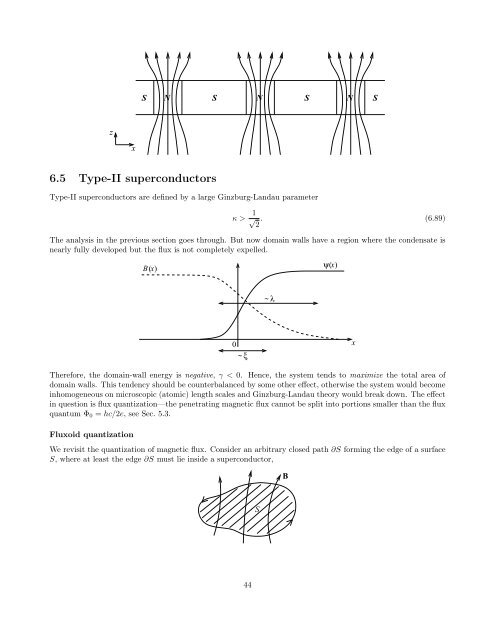Carsten Timm: Theory of superconductivity
Carsten Timm: Theory of superconductivity
Carsten Timm: Theory of superconductivity
You also want an ePaper? Increase the reach of your titles
YUMPU automatically turns print PDFs into web optimized ePapers that Google loves.
S N S N S N<br />
S<br />
z<br />
x<br />
6.5 Type-II superconductors<br />
Type-II superconductors are defined by a large Ginzburg-Landau parameter<br />
κ > 1 √<br />
2<br />
. (6.89)<br />
The analysis in the previous section goes through. But now domain walls have a region where the condensate is<br />
nearly fully developed but the flux is not completely expelled.<br />
B(x)<br />
ψ(x)<br />
~ λ<br />
0<br />
~ ξ<br />
x<br />
Therefore, the domain-wall energy is negative, γ < 0. Hence, the system tends to maximize the total area <strong>of</strong><br />
domain walls. This tendency should be counterbalanced by some other effect, otherwise the system would become<br />
inhomogeneous on microscopic (atomic) length scales and Ginzburg-Landau theory would break down. The effect<br />
in question is flux quantization—the penetrating magnetic flux cannot be split into portions smaller than the flux<br />
quantum Φ 0 = hc/2e, see Sec. 5.3.<br />
Fluxoid quantization<br />
We revisit the quantization <strong>of</strong> magnetic flux. Consider an arbitrary closed path ∂S forming the edge <strong>of</strong> a surface<br />
S, where at least the edge ∂S must lie inside a superconductor,<br />
B<br />
S<br />
44

















